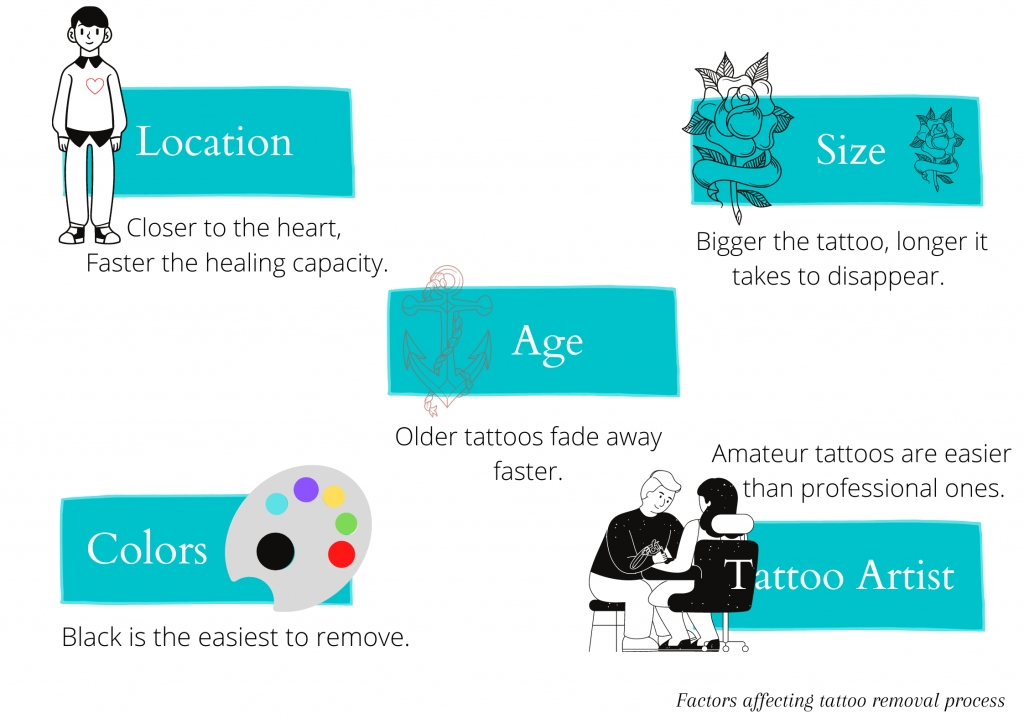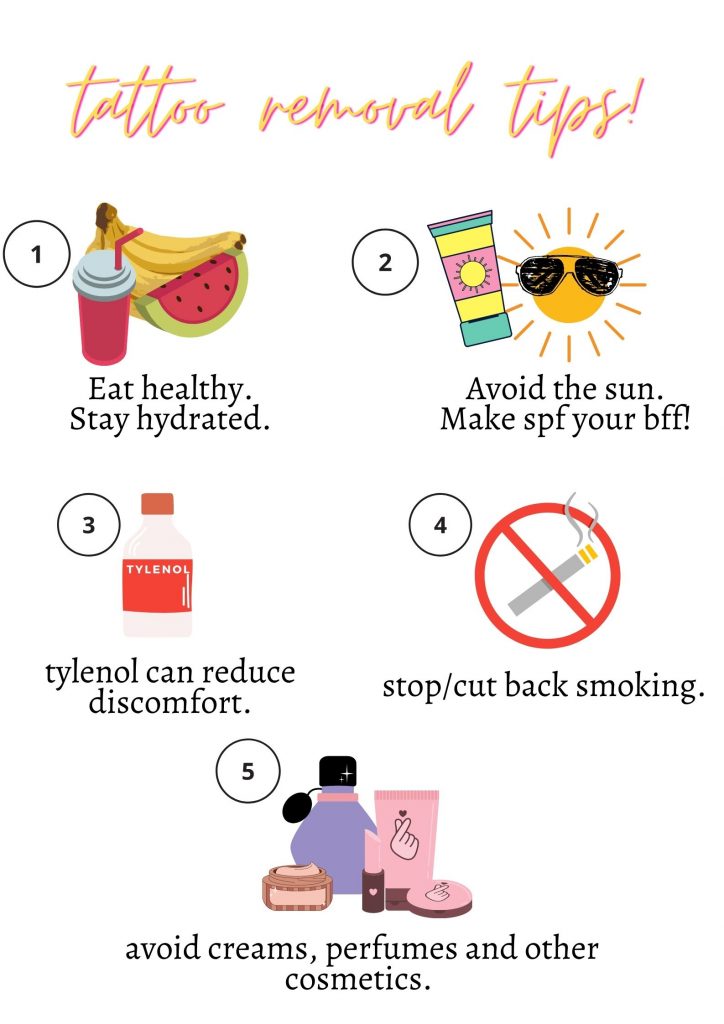Tattoo Removal Video
Agreeing to the ‘I understand that this procedure is a permanent change to my skin and body’ acknowledgment form seems like a cruel memory now. But fear not, contrary to other life-altering choices, this one can be reversed.
On a more serious note though, tattoo removal is possible.

Is Tattoo Removal Safe?
Tattoo removal is a safe and effective process as long as it is done in the right manner by the right person.
Will Insurance Cover Tattoo Removal?
Since tattoo removal is considered a cosmetic procedure, health insurance does not generally cover this. Insurance may be valid in some rare cases, when the procedure is considered a medical necessity.
Tattoo Removal At Home
To begin with, avoid home remedies. Scrubbing a tattoo with a solution of salt and water is not recommended. According to the American Academy of Dermatology (AAD), this is a ‘dangerous strategy’ and can cause pain, scarring, and even a serious infection. Other home remedies like rubbing sand or lemon juice on the tattoo, or using DIY tattoo removal kits, are not only ineffective but may also irritate the skin.
Tattoo Removal Cream
Buying one of the many tattoo removal creams available in the market is also not going to give the desired results. None of these products have been approved by the FDA. The chemicals in these creams can have serious side effects like scarring, burning, swelling, as well as other life-threatening allergic reactions. At best, it might leave a distorted version of the original tattoo.
This narrows it down to three possible solutions:
Surgical Tattoo Removal
Surgical Excision is a medical procedure where the tattooed skin is cut out and the remaining skin is stitched back together. The operation is performed by a licensed surgeon, who will provide all necessary instructions on before-and-after treatment care. Although this process can remove the tattoo completely, it’s an invasive skin treatment and is also very likely to leave a permanent scar on the body. This is the more affordable option compared to the other two.
Dermabrasion Tattoo Removal
This is also a medical procedure. Here a sanding device is used to remove the upper layers of the skin, allowing the tattoo ink to leach out. This is not a preferred method as its efficacy is highly questionable and varies from person to person.
Laser Tattoo Removal
This is the safest and the most cost-effective option to go for. In this treatment process, the laser penetrates the dermis layer of the skin where the tattoo ink resides and breaks them into smaller particles. These particles are then flushed out by the body’s immune system (aka your poop!).
Before undergoing a laser tattoo removal, there are a few things to know:
Not everyone can get a laser tattoo removal
Pregnant women, breastfeeding women, Accutane users, as well as people suffering from light-sensitive seizures, vitiligo, or keloids should not undertake this treatment. To avoid any kind of unforeseen complications, it is advisable to consult the doctor/laser technician first.
2. Final tattoo removal results may vary depending on a lot of factors –

Not every person’s experience with laser tattoo removal is going to be the same. Every tattoo is different, and thus its reaction to the treatment varies. While some tattoos may vanish completely, others may only reduce to a faded version of its former self. Some important factors affecting this are:
– Location: Tattooed region that receives healthy blood circulation heals fast, and needs fewer treatment sessions. An easy way to understand this – the closer the tattoo is to the heart, the better will be its healing capacity. Tattoos on the wrist, fingers, feet, and ankle are harder to remove and will likely take longer.
– Age: Older tattoos are easier to remove compared to new ones. Tattoos tend to fade over time. This is because the body tries to get rid of the ink from the moment it is injected, and it does so little by little over a period of time. The newer the tattoo, the more pigment it contains which makes it tougher to deal with.
– Colors: While black is the easiest, colors like yellow, turquoise, and other fluorescent shades are more difficult to treat. With the latest technology and the right person doing the job, even the most stubborn tattoo colors can fade away.
– Size: The size of the tattoo matters too. The bigger the tattoo, the longer it will take to disappear.
– Tattoo Artist: Amount and depth of ink matters. Amateur tattoos are generally easier to remove than those done by professionals. They generally have less ink and aren’t as deep in the skin as professional ones.
3. Tattoo removal on dark skin
Skin colour matters. Laser technology is yet to be inclusive, as dark-skinned patients face greater risks. Laser devices do not work well on darker skin tones- type 5 or type 6 skin. The laser fails to differentiate between the tattoo pigments and the skin. This may have serious side effects like Hyperpigmentation.
4. Tattoo removal risks
Laser removal is not without risks. It can cause scarring, burns, and even temporary or permanent changes in skin color (hyperpigmentation or hypopigmentation). Sensitive skin may trigger allergic reactions. The best way to avoid these risks is to be treated by an experienced dermatologist or laser technician and follow all aftercare instructions. Generally, the laser technician will do a patch test to analyze how the skin responds to the laser. Aggressive tattoo removal has higher risks of scarring. The skin left behind may not be flawless.
5. Laser tattoo removal cost

Laser removal can be costly. While each session costs $200-$500 on average, it can go as high as $1200 or as low as $50 depending on factors like size and colors. Moreover, many such sessions are needed before the tattoo completely fades away.
6. How many sessions to remove tattoo?
While each session may not be more than 15 minutes long, multiple sessions are needed to get rid of the tattoo completely. On average, it may take 6-10 sessions, which will be 4-8 weeks apart. It is important to allow the skin to heal before subjecting it to a laser again. This means that it could take as long as a year before the tattoo disappears.
Kirby-Desai scale:
Dr. Will Kirby and Dr. Alpesh Desai, skin specialists in tattoo removal, have created a system to predict the number of treatment sessions required for optimal results. This is known as the Kirby-Desai scale. It is based on six factors – patient skin type, location of the tattoo, color(s) of ink, amount of ink, scarring/tissue change, and layering/cover-ups. This can also help in calculating a rough budget.
7. Tattoo removal pain
Tattoo removal can cause discomfort, but the actual pain may vary depending on individual tolerance level. Some have described the sensation as ‘flicking an elastic band against the skin’. Laser removal in bony areas such as ribs, ankles, and wrists tends to be more painful. Cold compresses, numbing cream, chilled air, and/or local anaesthesia is provided to bring down the pain factor. Although not proven, the treatment may be more painful during periods. It is advisable to book appointments accordingly.
8. Where to get a tattoo removed?
Given the technicalities and risks, make sure that the treatment is performed by an experienced person. Going through reviews on sites like Yelp and Trust Pilot of tattoo removal clinics can help make an informed choice.
9. Do not mix antibiotics and tattoo removal
Antibiotics tend to make the skin more sensitive. This may have harmful side effects when coupled with laser treatment. It is advisable to wait till the medication is complete. Always discuss medicines and medical history with the doctor/laser technician.
10. Preparations before the laser tattoo removal treatment- Few things to keep in mind:

– Eat well and stay hydrated before each session to avoid risk of fainting during the laser procedure.
– Smoking affects the body’s healing capacity. Hence, it is advisable to quit smoking or at least not smoke during the treatment period.
– For at least four weeks before the session, protect the tattoo from the sun. Tanned skin can react to the laser light and cause irreversible pigment changes.
– Taking Tylenol before each session can reduce pain and discomfort during the treatment process. Avoid taking Ibuprofen or Aspirin. They will likely cause bruising if consumed.
– Keep the tattooed region clean and clear. Avoid creams, perfumes, and other cosmetics.
11. Tattoo removal healing
After a session, the treated region is likely to experience redness, swelling, blistering, and/or bruising. It is important to follow a few aftercare tips for the best possible results. Keep the region covered with bandages until the skin has healed. Do not scratch, pick or unnecessarily touch the treated skin. Applying antibiotic ointment like Aquaphor also helps in the healing process. Avoid wearing clothes that may touch and irritate the affected area. Use sunscreen when going out.
The speed of the removal process depends on the body’s immune system. It is important to make sure that the body feels healthy and calm. Drink a lot of water (8-10 glasses a day is advisable), exercise but do not overdo it, and avoid stress.
12. Not getting it all removed- cover-up tattoos:
Instead of getting the tattoo removed completely, lighten the tattoo ink enough to allow for a cover-up tattoo. This will need fewer sessions.
Tattoo removal has become a realizable dream, thanks to laser tattoo removal. It is time to get rid of embarrassing tattoo regrets!
Want to see our take on the worst tattoo failures ever? Read this article!




